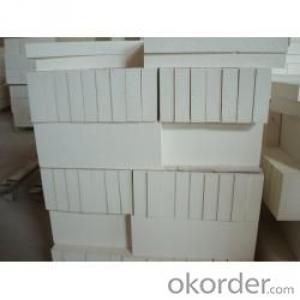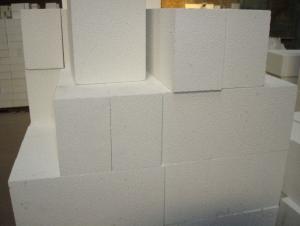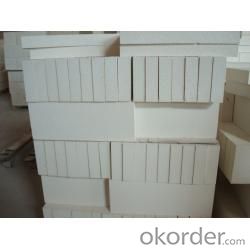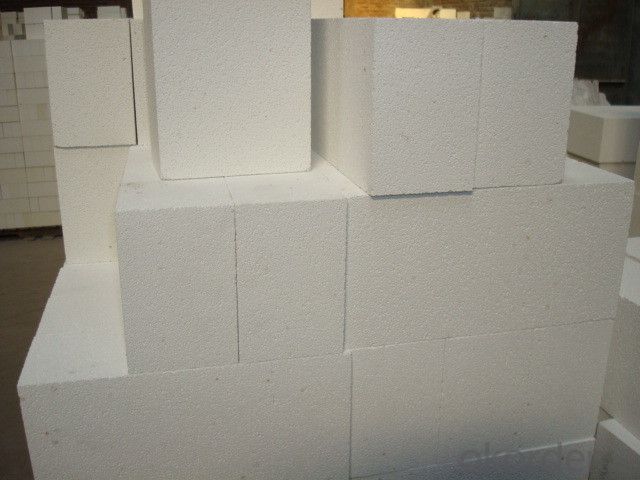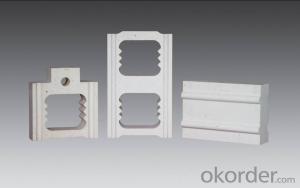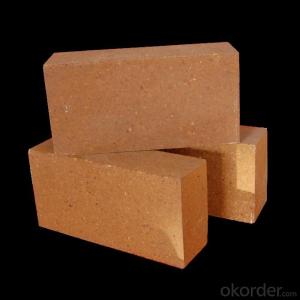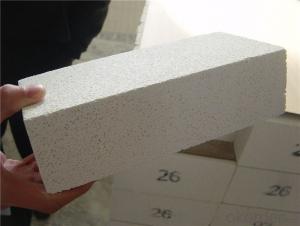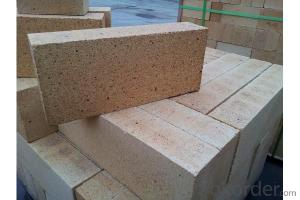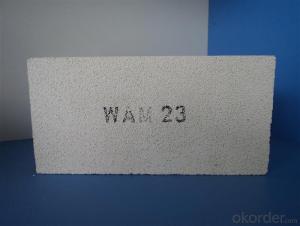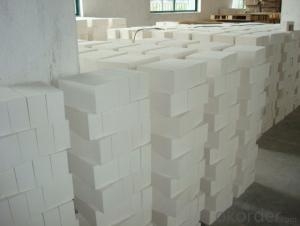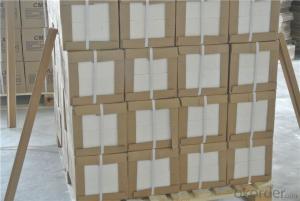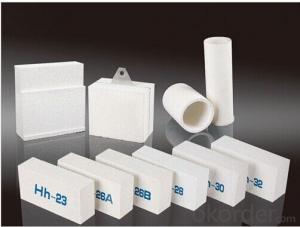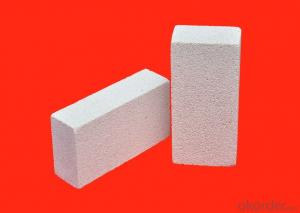Mullite Insulating Fire Brick - Thermal Storage & Thermal Insulating Brick
- Loading Port:
- Shanghai
- Payment Terms:
- TT OR LC
- Min Order Qty:
- 1 m.t.
- Supply Capability:
- 1000 m.t./month
OKorder Service Pledge
OKorder Financial Service
You Might Also Like
CNBM conforms strictly to the requirements of ISO 9000 quality control system during the production. MSDS is also available if you want. The thermal insulation fire clay brick meet with the requirements of ASTM & JIS standards. So please stay cool with our quality.
Application
Insulating Fire Brick are used for the lining of converter, alternating current arc furnace, direct Current arc furnace and the ladle slag line, etc.
Insulating Fire Brick Technical index
Brand Quality | JM23 | JM26 | JM28 | JM30 | JM32 | |
Bulk Density (g/cm3) | 0.52 | 0.78 | 0.88 | 1.03 | 1.25 | |
1.2 | 1.6 | 2.1 | 2.5 | 3.5 | ||
Modulus of Rupture (Mpa) | 0.9 | 1.4 | 1.6 | 2.1 | 2.1 | |
-0.5 | 1400℃ -0.4 | 1510℃ -0.5 | 1620℃ -0.9 | 1730℃ -0.9 | ||
Thermal Expansion 1100℃(%) |
0.5 |
0.7 |
0.8 |
0.9 |
1.1 | |
Thermal conductivity(W/m.k)
| 400℃ | 0.14 | 0.27 | 0.32 | 0.41 | 0.49 |
600℃ | 0.16 | 0.29 | 0.34 | 0.43 | 0.50 | |
800℃ | 0.18 | 0.31 | 0.36 | 0.44 | 0.51 | |
1000℃ | 0.20 | 0.33 | 0.38 | 0.45 | 0.53 | |
Al2O3 | 37 | 58 | 67 | 73 | 77 | |
Fe2O3 | 0.7 | 0.7 | 0.6 | 0.5 | 0.4 | |
Equipment
1 unit of Ceramic Abrasive (SG Abrasive) pilot production line
2 units of Compact grain Abrasive pilot production lines
1 unit of high-end coated abrasives (abrasive cloth) production line
2 units of Boron Carbide production lines
3 large flexible crushing and sieving lines for grit production lines
2 units of 2000KVA furnaces for Boron Carbide fusion
6 units of 5000KVA-10000KVA dumping type electric arc furnaces for Brown Fused Alumina fusion
Company Advantage
(1)Long Insulating Fire Brick manufacture history: 25 years manufacturer
(2)Advanced equipment
(3)Diversification of production standards: ISO ANSI FEPA JIS ASTM
(4)Flexible payment: T/T L/C D/P D/A
(5)Professional marketing team and after-sale service
(6)Free sample
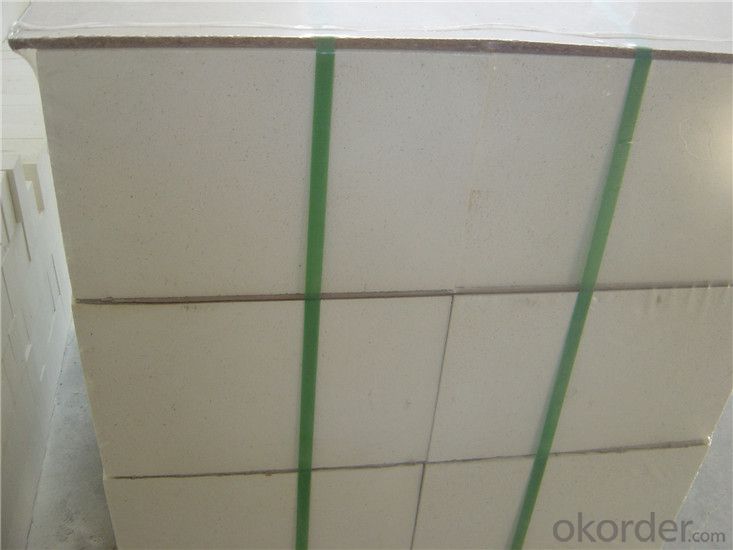
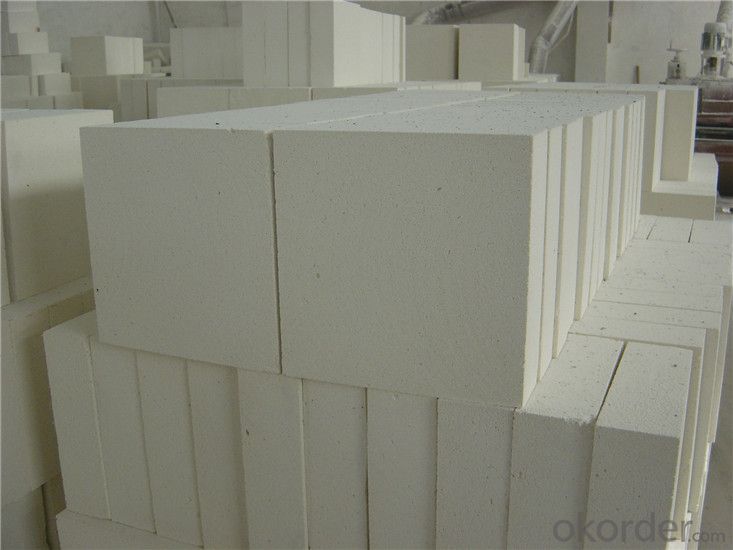
- Q: The project cost in hydropower No.3 shaft wall is solid brick or insulating brick?
- Aerated concrete for external walls is to save money. One side is the outer wall.. Solid bricks are the first thing, safety comes first.
- Q: Are insulating fire bricks easy to cut or shape?
- Insulating fire bricks are relatively easy to cut or shape compared to other types of bricks. This is primarily due to their lower density and composition, which allows them to be more easily manipulated with standard masonry tools. However, it is important to note that the level of ease may vary depending on the specific type and brand of insulating fire brick. Some may require special tools or techniques for cutting or shaping, while others may be more user-friendly. It is always recommended to consult the manufacturer's instructions or seek professional advice when working with insulating fire bricks to ensure proper cutting or shaping techniques are employed.
- Q: How do insulating fire bricks affect the overall insulation properties of a structure?
- Insulating fire bricks play a vital role in enhancing the insulation properties of a structure. These bricks are specifically designed to have low thermal conductivity, enabling them to effectively resist heat transfer. Consequently, they act as a barrier, preventing heat from escaping during cold weather and blocking external heat intrusion during hot weather. The utilization of insulating fire bricks significantly improves the overall thermal insulation of a structure. These bricks possess high porosity and low density, allowing them to trap air within their structure. This trapped air acts as an exceptional insulator, creating a thermal barrier that minimizes heat transfer through conduction, convection, and radiation. Consequently, the heat loss or gain through the walls, floors, and roofs of a building is notably reduced. Furthermore, insulating fire bricks exhibit excellent refractory properties, enabling them to withstand high temperatures without deforming or deteriorating. This characteristic is crucial in applications where the structure is exposed to extreme heat, such as industrial furnaces or kilns. By maintaining their structural integrity under high temperatures, these bricks ensure that the insulation properties of the structure remain intact even in challenging environments. Overall, the use of insulating fire bricks has a positive impact on the insulation properties of a structure. They effectively reduce heat transfer, conserve energy, and maintain a comfortable indoor environment. Additionally, their durability and resistance to high temperatures make them a dependable choice for insulation in various industrial and residential applications.
- Q: Can insulating fire bricks be used for insulation in industrial chimneys?
- Yes, insulating fire bricks can be used for insulation in industrial chimneys. Insulating fire bricks are designed to withstand high temperatures and provide excellent thermal insulation. Their low thermal conductivity helps to reduce heat loss, increase energy efficiency, and maintain high temperatures inside the chimney. Consequently, they are commonly used in industrial chimneys to enhance insulation and improve overall performance.
- Q: Can insulating fire bricks be used for insulation in autoclaves?
- Insulating fire bricks have the capability to be utilized for insulation within autoclaves. These bricks are specifically engineered to possess a minimal thermal conductivity, enabling them to proficiently retain heat and endure elevated temperatures. The insulation of autoclaves necessitates the ability to sustain a steady temperature and pressure, and insulating fire bricks excel in delivering exceptional insulation properties amidst these challenging circumstances. Furthermore, their robustness and durability render them well-suited for enduring the rigorous heat and pressure fluctuations commonly encountered in autoclaves. All in all, insulating fire bricks emerge as a dependable and efficient option for insulating autoclaves.
- Q: Are insulating fire bricks resistant to thermal bridging?
- Insulating fire bricks possess resistance against thermal bridging. Thermal bridging arises when a material allows heat to flow directly, thereby bypassing the insulation. Insulating fire bricks counteract this issue by minimizing thermal conductivity, which renders them ineffective at conducting heat. This characteristic aids in maintaining a uniform temperature on either side of the brick, thereby preventing thermal bridging and enhancing the overall insulation performance.
- Q: Are insulating fire bricks resistant to reducing atmospheres?
- Yes, insulating fire bricks are resistant to reducing atmospheres.
- Q: Are insulating fire bricks resistant to sulfur dioxide?
- Yes, insulating fire bricks are resistant to sulfur dioxide.
- Q: Do insulating fire bricks require a refractory mortar for installation?
- For proper installation, insulating fire bricks typically require the use of refractory mortar. These bricks are lightweight and have excellent insulating properties, making them well-suited for applications that prioritize thermal efficiency. However, their lightweight nature also means they are more fragile and susceptible to cracking or breaking when subjected to stress. To establish a robust and durable bond between the bricks, it is essential to use a refractory mortar specifically designed for high-temperature applications. These mortars are formulated to withstand high temperatures and possess superior adhesion and thermal expansion properties. By filling in the gaps between the bricks and providing additional support, this mortar helps create a solid and secure structure. Failure to use refractory mortar can lead to inadequate securing of the insulating fire bricks, potentially causing them to shift or separate over time and compromising the integrity of the installation. Additionally, the absence of refractory mortar may result in reduced thermal efficiency due to increased heat loss through gaps and spaces between the bricks. Therefore, it is highly advisable to employ refractory mortar when installing insulating fire bricks to ensure the construction remains strong and long-lasting.
- Q: Can insulating fire bricks be used in the construction of smelting crucibles?
- Yes, insulating fire bricks can be used in the construction of smelting crucibles. Insulating fire bricks are designed to withstand high temperatures and provide excellent insulation. They are commonly used in applications that require heat retention and protection, such as kilns and furnaces. Smelting crucibles, which are used to melt and refine metals, also require materials that can withstand extreme temperatures. Insulating fire bricks are an ideal choice for constructing smelting crucibles because they can help maintain a consistent temperature within the crucible and prevent heat loss. Additionally, their insulating properties can reduce energy consumption and increase the efficiency of the smelting process.
Send your message to us
Mullite Insulating Fire Brick - Thermal Storage & Thermal Insulating Brick
- Loading Port:
- Shanghai
- Payment Terms:
- TT OR LC
- Min Order Qty:
- 1 m.t.
- Supply Capability:
- 1000 m.t./month
OKorder Service Pledge
OKorder Financial Service
Similar products
Hot products
Hot Searches
Related keywords
